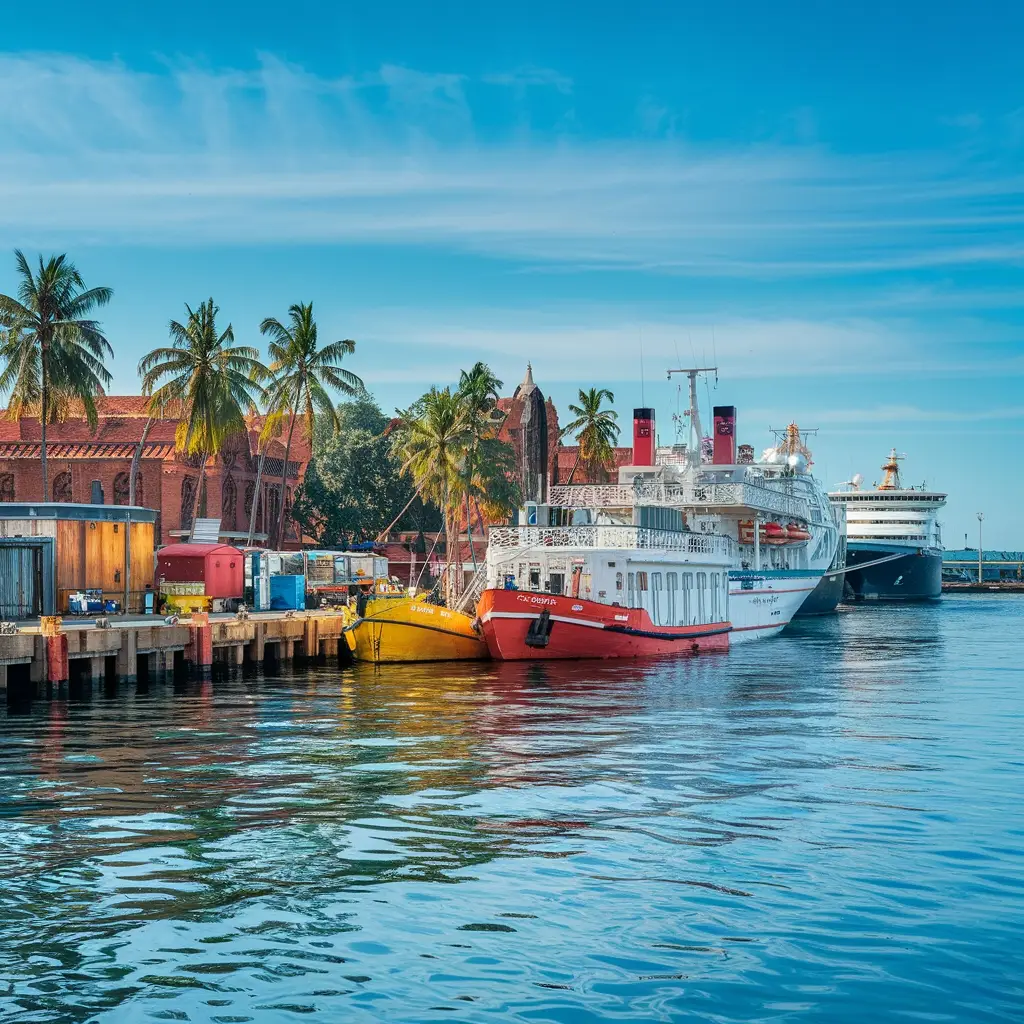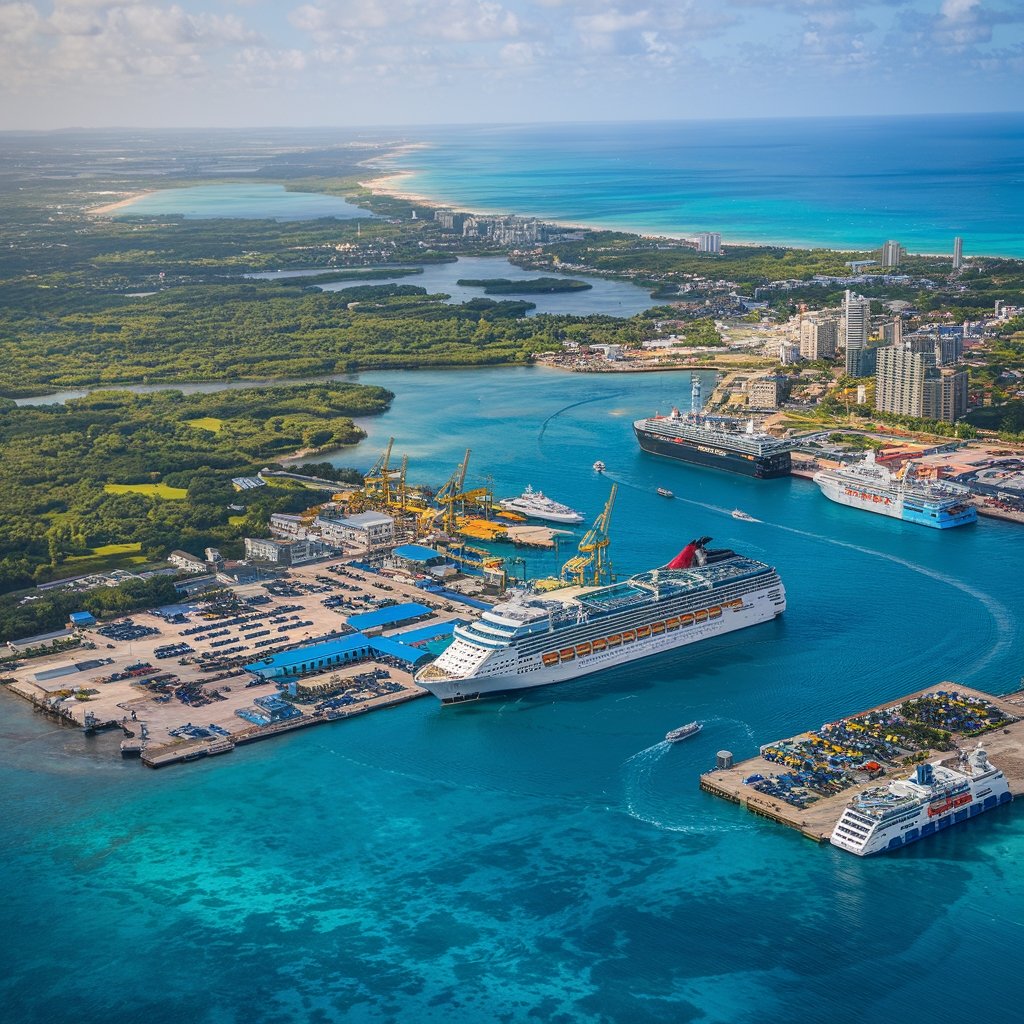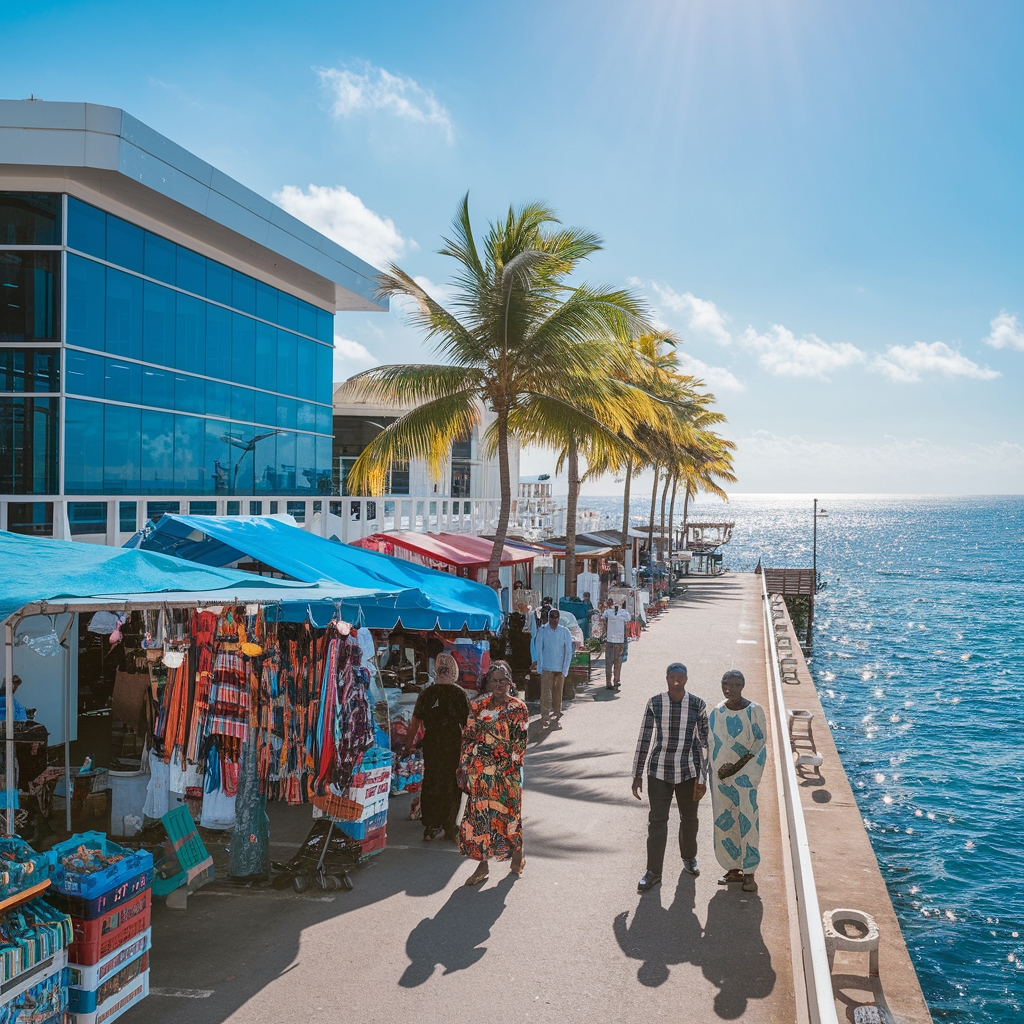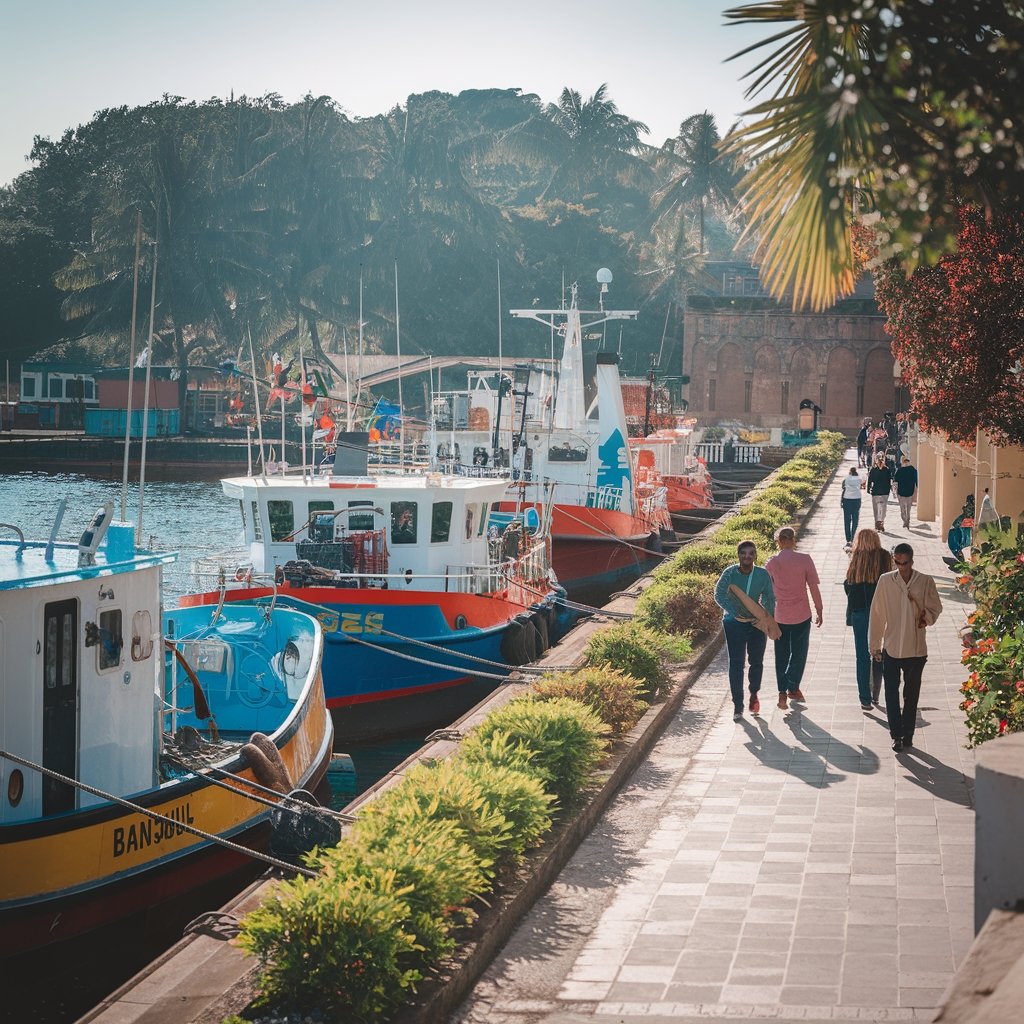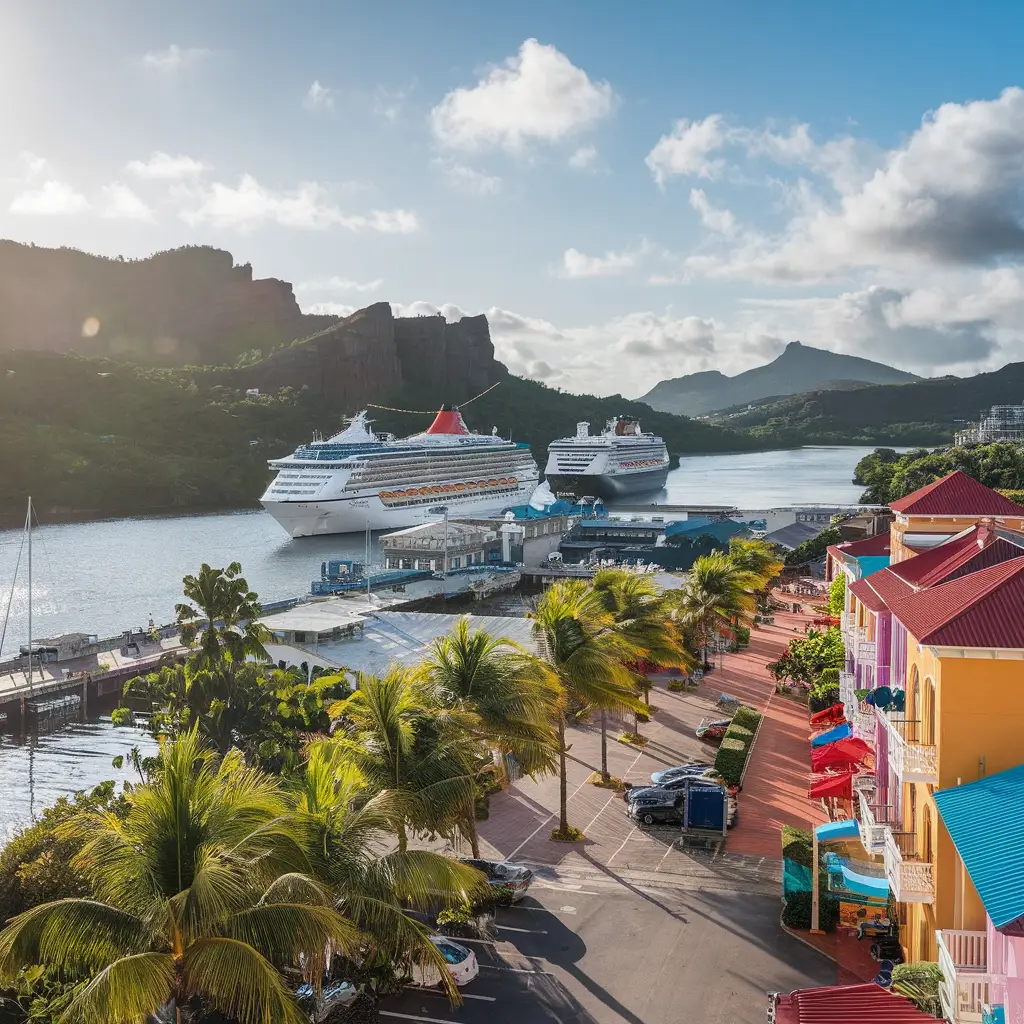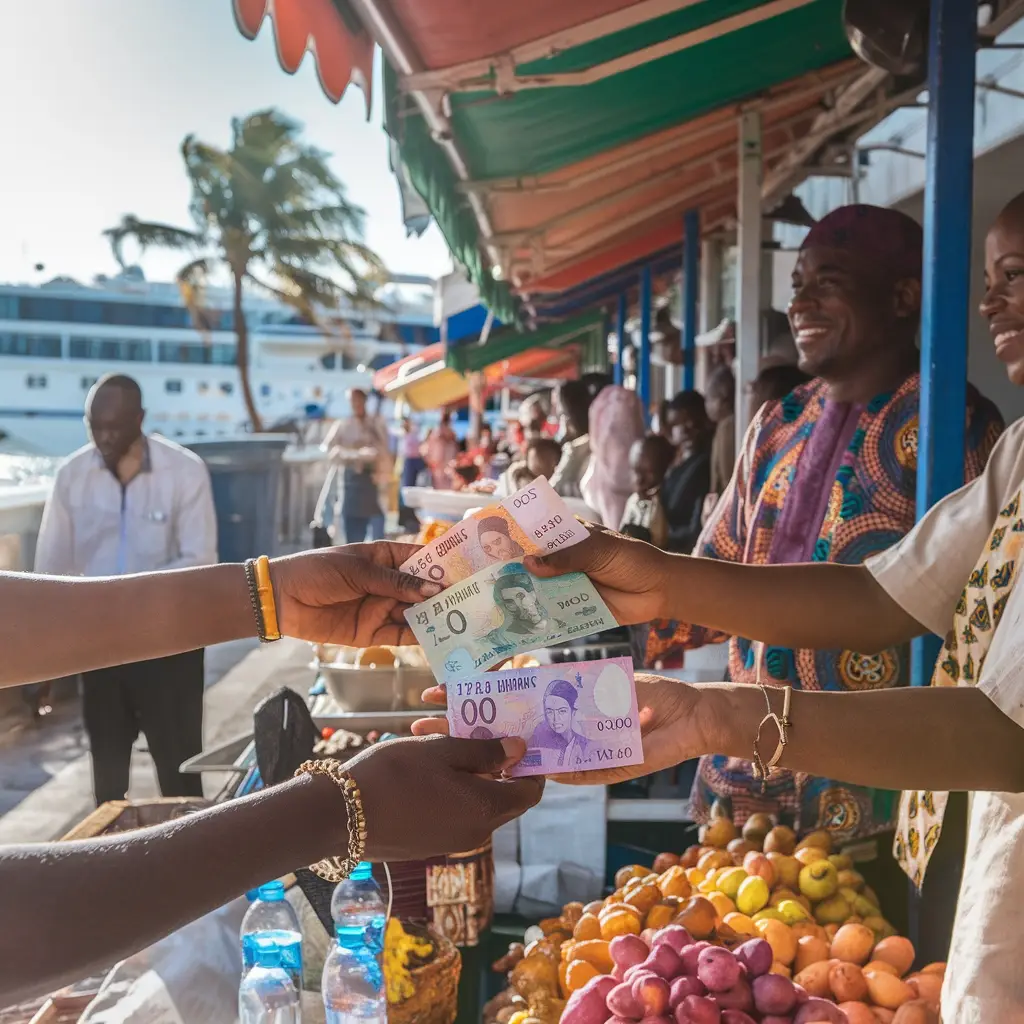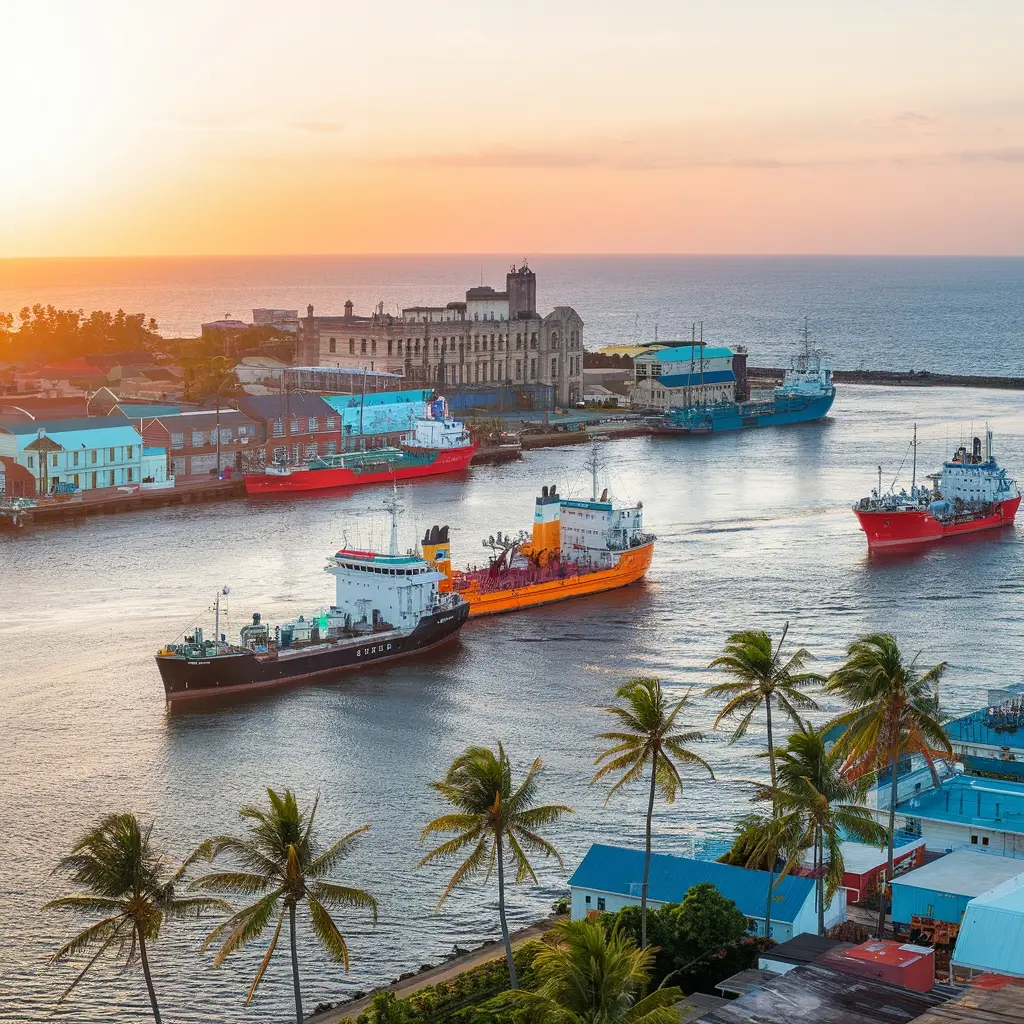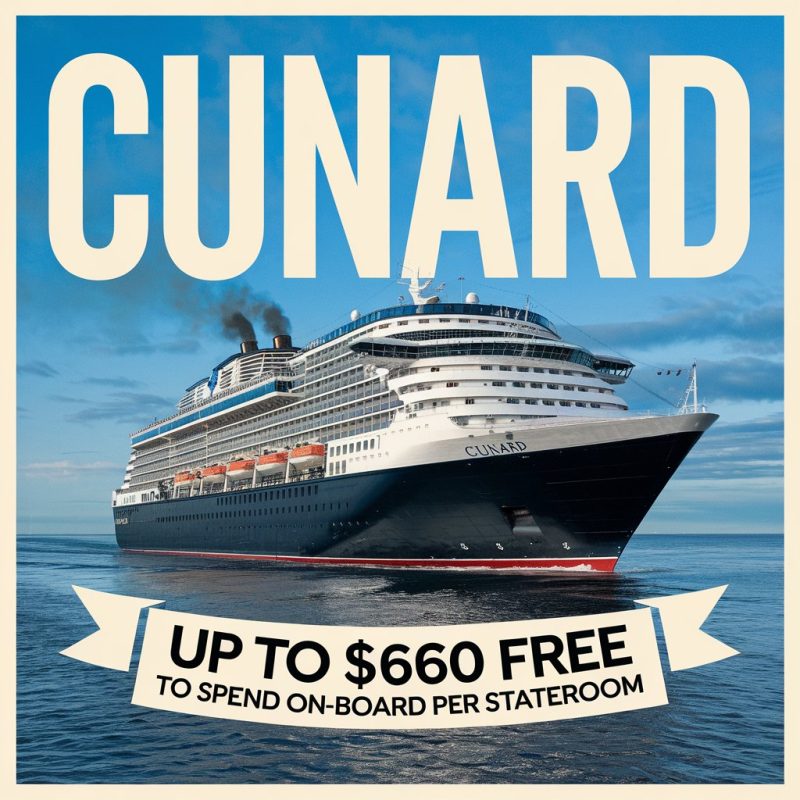Banjul’s cruise port is nestled right where the Gambia River meets the sea on Banjul Island. The terminal has just the basics, but you can snag free Wi-Fi at nearby places.
Most folks fly into Banjul International Airport or grab a taxi to reach the port. Once your ship docks, you’ve got options – hop on the port shuttle, flag down a local taxi, or rent your own wheels to explore.
Plan your trip between November and April when temperatures hover between a comfortable 21°C-29°C. Remember to bring some Gambian Dalasi since cash rules around here.
Check out the rest of this guide for all the nitty-gritty details you’ll need for your Gambian adventure.
Map of Banjul The Gambia Cruise Ship Port
Where is The Port Located?
Banjul’s cruise port hangs out right where the Gambia River meets the Atlantic Ocean. You’ll dock at coordinates 13.4424°N, 16.5708°W on Banjul Island (folks also call it St. Mary’s Island) – a small patch of land about 12 km².
When you step off the ship, you’re in the middle of a working industrial area that basically runs Gambia’s economy. Not exactly postcard material right at the dock, but don’t worry – Albert Market is just a quick 1-1.5 km stroll away. You can also easily walk to MacCarthy Square and check out the King Fahad Mosque with those cool twin minarets towering over everything.
How to get to the port, by air, train, road
Getting to the Port: Air & Road Options
You’ve got two real ways to reach Banjul’s cruise port – not three as you might expect. Train service? Forget about it – The Gambia doesn’t have any rail system whatsoever. That leaves you with flying or driving.
If you’re flying in, Banjul International Airport (BJL) connects with several European and West African cities. Expect to shell out $30-50 for a taxi ride from the airport to the port.
- Grab flights on Brussels Airlines, Air Senegal, or TAP Air Portugal
- Want comfort? Book a private transfer with AC ahead of time
- Coming from Senegal? Use the Trans-Gambia Highway or the newer Senegambia Bridge
- Approaching from the north? Hop on the Banjul-Barra ferry
- Taxis don’t use meters, so haggle your fare before getting in
Port Parking Options
The cruise port in Banjul doesn’t have much parking space, so you’ll need to plan ahead. The port runs shuttle services for passengers, and they don’t let taxis drive through the port gates. Your best bet is to use these official shuttles instead of trying to park at the port yourself.
Some hotels close to the port offer “cruise and stay” deals that include parking and a ride to the terminal. Worth checking out these places ahead of time – they’re usually your top choice when visiting this part of West Africa. Just keep in mind that Banjul’s port setup is quite different from what you’d find in North America, with more focus on organized transport rather than bringing your own car.
Local Transport & Transfers
Local Transport & Transfers
Fresh off your cruise ship in Banjul? You’ve got plenty of ways to get around Gambia’s buzzing capital. Port authority shuttle buses are your best bet – they skip past those annoying gate restrictions that block other vehicles and run perfectly with your ship’s timetable.
- Shuttle buses run whenever needed during port hours—just hop on, no booking hassle
- Those “bush taxis” (shared vans) are dirt cheap once you’re outside the port gates
- Passenger ferries chug across to Barra every hour if you fancy exploring the other riverbank
- Need your own wheels? Rental cars with round-the-clock roadside help are just a stone’s throw (2km) from port
- English-speaking guides will show you around and guarantee you won’t miss your boat
- Shuttle buses run whenever needed during port hours—just hop on, no booking hassle
Port Terminal Facilities and Accessibility
Stepping onto Banjul’s port facilities, you’ll find a practical mix of maritime infrastructure serving both cruise passengers and commercial shipping. The cruise terminal at Kotu Quay has basic amenities for when you arrive, while the modern passenger terminal handles customs and luggage efficiently.
You can grab free Wi-Fi at The Gambia Adventure office or nearby cafés. The port sits at 13°27’N, 16°34’W, and when boats come in, they need to watch for the 1.6-meter tide changes. When you’re ready to head out, air-conditioned coaches and 4x4s are waiting to take you to the local sights.
Things to Do Before Your Cruise in a Day
Only Got a Day in Banjul Before Your Cruise?
Got just a few hours in Gambia before setting sail? No worries! You can still soak up the local flavor and knock out some must-sees. Here’s how to crush your pre-cruise day:
- Wander through Albert Market and grab some one-of-a-kind crafts and colorful fabrics. While you’re there, munch on benachin and other street eats.
- Pop up to Arch 22 for killer views of the city and a quick history lesson
- Hang out with the sacred crocs at Kachikally Crocodile Pool (yeah, real crocodiles!)
- Chow down on super-fresh seafood at one of the family spots near Tanji Fishing Village
- Squeeze in a quick boat ride on the River Gambia to catch some wildlife action
Walks near the port
Stepping off your ship in Banjul, you’re just a quick walk from where all the action happens. The street layout is super straightforward, though you’ll have to deal with some dusty port vibes and dodge a few trucks at first.
Want a taste of local life? Albert Market is about a 15-20 minute walk and absolutely worth it. If you’re feeling energetic, the National Museum and St. Mary’s Cathedral are a bit further (about 1-2km). On your way, you’ll spot the Quadrangle, which houses the national archives.
Just a heads-up – keep an eye on your stuff in busy spots and definitely bring water. It gets crazy hot around midday – we’re talking 38°C with humidity that’ll have you sweating buckets! If you’re into the history, especially around the slave trade sites, grabbing a guide isn’t a bad shout.
Dining and Shopping
Dining and Shopping
Get ready to eat your way through Banjul! Three food scenes await cruise visitors: fancy international spots, down-home local joints, and breezy beachfront seafood places. If you’re watching your wallet, head to the vendors near the port – their kebabs and fried plantains will only set you back a couple bucks.
Shopping? You’ve got options:
- Albert Market’s bursting with bright textiles and cool wood carvings
- Tanji Village Craft Market’s the spot for real-deal batik fabrics
- Beach stalls packed with handwoven baskets and tribal bling
- Need duty-free? Hit the shops by the cruise terminal for booze and perfume
- Grab a wooden mask or traditional instrument from the locals
Don’t leave without trying Yassa or Benachin rice, washed down with a refreshing Baobab juice. Trust me, your taste buds will thank you!
Accommodation near the port
Tired from hauling all your market goodies? Time to crash somewhere comfy! You can snag a room from as cheap as $23 a night at Senegambia Beach Hotel, or go all-out with a fancy stay at Ocean Bay Hotel & Resort for over $150.
Most places to stay are about 1-5km from the cruise port. Lemon Creek Hotel is pretty convenient – just 1.5km away with direct shuttles running to and from the port, plus it’s right by the National Museum. Not many hotels are close enough to walk, but no worries – taxis are super cheap at only $10-15.
Want to wake up to ships coming into port? Try Banjul Beach Hotel where some rooms have sweet views of Arch 22. Just a heads-up – if you’re visiting during the busy season (November through March), expect to shell out an extra 30-50% for your room.
Customs & Immigration at The Port
Customs & Immigration at The Port
Coming into Banjul port on your cruise? You’ll need to deal with some basic entry stuff. Your cruise line usually takes care of most paperwork, but here’s what you should know:
- ### Bring your passport with at least one empty page, and make sure it won’t expire during your trip
- ### Got your yellow fever vaccination card? Keep it on you at all times
- ### Visa might cost you $108 – though some countries’ citizens can grab one when they arrive
- ### Bringing goodies? You’re allowed 200 cigarettes, 1 liter of the hard stuff, and 1 liter of wine
- ### Watch where you point that camera! Government buildings are off-limits for photos – best to ask first
Local Currency & Payment Options
Money Talk: The Gambian Dalasi
Once you’ve sorted your entry paperwork, you’ll need to get your head around Gambian cash. You’ll be using the Gambian Dalasi (GMD) during your trip – right now it’s floating around 70.87 GMD to the US dollar.
Don’t fall for the currency hustlers at the port! Head to legit exchange spots like Yonna in Bakau for decent rates. Smart travelers pack plenty of small bills (5-25 GMD) for tipping and haggling at markets. Fancy hotels will take your plastic, but everywhere else, cash rules.
Need more cash? ATMs in Banjul spit out dalasi, though give your bank a heads-up before you jet off. Don’t bother changing money before your trip – nobody stocks dalasi outside The Gambia anyway. Stash your extra cash in the hotel safe, and download XE or something similar to keep an eye on rates.
Emergency Contacts
Emergency Contacts
Keep those emergency numbers handy while exploring Gambian ports – it could save your bacon! The Gambian Police Force runs a 24-hour emergency line at (220) 422-4914 that you’ll definitely want to program into your phone. Port security does their best, but honestly, they’re working with less equipment than what you’d find at bigger ports.
- Your cruise ship posts emergency contacts in their daily bulletins
- Don’t miss that boarding time unless you fancy being left behind
- If you do get stuck, local port agents will hang onto your passport
- Coast Guard can shuttle you back if there’s a serious water emergency
- Americans should check travel.state.gov before the trip for any Gambia warnings
History of The Port
The port’s changed big time over the years – we’ve added new jetties, container terminals, and bonded warehouses all over the place. You can still spot some old-school maritime traditions that take you back to colonial days, but the GPA keeps pushing forward with fancy computer systems and better logistics setups that’ll make your visit smoother.
Best Times of Year to Cruise from The Port
When’s the best time to cruise to Banjul? Go during the dry season from November to April – you’ll get perfect weather with temps between 21°C–29°C and hardly any rain. December through February gets pretty packed with tourists, but if you book in November or April instead, you’ll enjoy similar sunshine with way fewer people and probably save some cash too.
- November and April see about a quarter fewer tourists while still giving you mostly dry days
- Wildlife watching is awesome in the dry season – tons of migratory birds and you might catch turtles nesting
- If you’re into cultural stuff, December-February has more festivals, but book your excursions early
- The shoulder seasons still have lovely 24°C–27°C weather plus fewer ships hogging the port
- Just don’t even think about May-October – brutal 85-95% humidity and enough rain to mess up sailing completely
Frequently Asked Questions
Is It Safe to Explore Banjul Independently as a Cruise Passenger?
While wandering around Banjul on your own isn’t the best idea due to safety issues, honestly. You might run into problems with crime or get your stuff nicked. Your best bet is sticking with the organized tours from your ship – at least then you’ve got guides watching your back and some actual security.
Are There Any Cultural Etiquette Guidelines Visitors Should Know?
Making friends with locals is way easier if you throw in a “salaam aleikum” when saying hi. Pack clothes that cover your shoulders and knees – no need to go overboard, just show some respect. Stick to your right hand for food and handshakes (the left is a no-go for cultural reasons). Oh, and if someone invites you over, don’t show up empty-handed – even a small gift goes a long way.
What Vaccinations Are Recommended Before Visiting the Gambia?
Planning a trip to The Gambia? You’ll definitely need a yellow fever shot – it’s actually required for entry. Make sure to get hepatitis A, typhoid, and tetanus vaccines too, and don’t forget to start malaria pills before you go. If you’re traveling during the dry season (December through June), think about getting a meningitis vaccine. And if you’re staying for a while or heading into rural areas, a rabies vaccine might be a good idea too.
Can I USe US Dollars or Euros Throughout Banjul?
You’ll need Gambian Dalasi for most stuff in Banjul. Sure, some touristy places might take US dollars or euros, but the exchange rates will be pretty awful. Better to swap your currency beforehand if you’re planning to check out the local markets.
What Are the Most Authentic Local Souvenirs to Purchase?
Look out for some real local gems – those gorgeous handwoven baskets with all their geometric patterns, colorful batik fabrics showing off traditional designs, cool wooden carvings, and stunning silver jewelry. The kora instruments are totally worth grabbing, and don’t walk past those baobab oil products made by local craftspeople!

